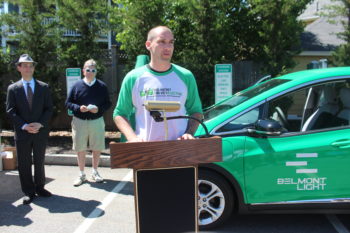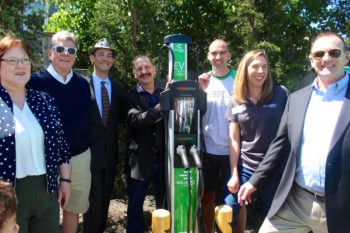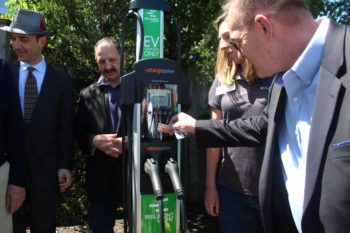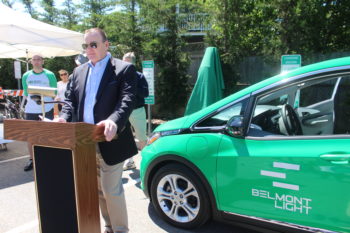Photo: At the dedication of the new public charging stations in Belmont Center (from left); Interim Town Administrator Phyllis Marshall, Selectmen Jim Williams, Adam Dash and Mark Paolillo, Energy Committee’s Marty Bitner, and the Light Department’s Rebecca Keane and Jim Palmer.
Belmont Center has become a destination location for owners of “EVs” as town leaders joined officials from the municipal utility in dedicating the community’s first public charging stations for electric cars on Town Day, Saturday, May 20.
The chargers are located in the right rear section of the Claflin Street Municipal Parking Lot in Belmont Center.
“If you build it, they will come, and so we expect to see people who have electric vehicles in our area to come [here] and visit our business center,” said Selectmen Chair Jim Williams, who was joined by fellow selectmen Adam Dash and Mark Paolillo and interim Town Administrator Phyllis Marshall to help Jim Palmer, general manager of Belmont Light, the town-owned electrical company, plug in the first vehicle – a new Belmont Light electric car – into the station.
“We expect it to be a competitive advantage to benefit the [new] development in the Center,” Williams said. “It’s a win/win situation.”
Light Department worked with the town’s Energy Committee and town departments including the Department of Public Works. The funds used to purchase the stations and three Chevy Bolt EVs – in use by the Health and Facilities departments in addition to Belmont Light – came from a grant written by Facilities Manager Gerald Boyle and Rebecca Keane from Belmont Light.
“The greatest source of residential carbon emissions [in Belmont] comes from transportation,” said the Energy Committee’s Marty Bitner who is also a member of Belmont Drives Electric, an ad hoc group which promotes the purchase of electric cars with events such as ride alongs with e-car owners and promotions.
“The impetus behind this program is to encourage people to drive electric vehicles and reduce their carbon footprint,” Bitner said, as the town’s commitment to infrastructure such as the chargers provides “tacit support” for residents who are thinking to move to an electric car.
And it appears an increasing number of Belmont residents are receptive to the message. Bitner revealed that in the past eight months since the Belmont Drives group started its program, Belmont has seen the highest per capita increase in electric cars either bought or leased in the state, jumping from 50 to 88 vehicles.
“It’s been incredible to watch the Belmont community to come together to support EVs,” said Palmer, noting that 2016 was a landmark year for electric vehicles and with the new stations “Belmont residents are ahead of the curve.”






